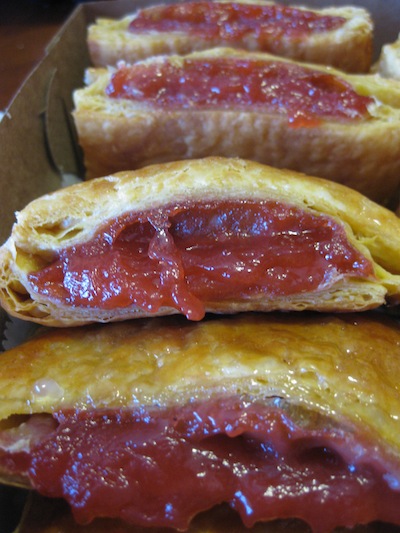 THE CUBAN SWEETS.THE BREAD WITH TIMBA OR GUAVA.
THE CUBAN SWEETS.THE BREAD WITH TIMBA OR GUAVA.
We owe Spaniards many things, good and bad, but above all a very important one, the habit of breakfast, lunch and dinner … and dessert, because it is who gives the final bouquet of food. The sweets in Cuba did not emerge properly from the convents of nuns as in Spain and other countries, but come from the popular tradition of migratory flows that nurtured our nationality.
In Cuba we have a great pastry tradition partly due to Spanish heritage and also because of the great production of cane sugar, honey and tropical fruits with which a very large variety of jams and basic preparations are prepared that will serve as a filling or will be part of the elaborations of sweets in bakeries and kitchens.
In Cuba there was a saying that said: “Without sugar there is no country” that some have forgotten or never knew; life showed us that without sugar there is still a country, but there are no tasty sweets.
I think you can still taste a delicious “bread with timba”, the food of the masons who for less than 10 cents had a bread with guava paste and the old Materva soft drink, the largest volume there was. A guava bar weighing a pound of weight properly stored in a wooden box, cost 12 cents, now a lower quality costs 12 pesos, but still for the Cuban remains the bread with timba as the national candy.
BREAD WITH TIMBA OR BREAD WITH GUAYABA PASTA.
When the British arrived in Cuba in 1874 to install railroad tracks (the first in the Americas) from Bejucal to Havana, they saw with surprise that the workers at lunch ate Pan con Guayaba (at that time the guava bars were made in the houses and with brown sugar, reason why its color was black).
The wooden trunks that were laid to make the railway were given an oil bath so they became black. In English, these transoms are called Timber ties. The English told their employees: that looks like a Pan con timber. That’s where the name Pan con timba came from.
As much as he eats, the average Cuban feels he lacked something if he did not have a generous portion of rice at his table. Something similar happens with the candy. In “Morder las bellas rocas” by Lisandro Otero, two women talk:
“I’m hungry.
“But if you just finished lunch,” said the thin one.
“It’s just that I did not eat dessert. When I do not eat dessert, I feel like I have not eaten. ”
Sugar is part of our food culture. The preference for the sweet, favored by the sugar industry, is one of the constants of the Cuban palate, so without sugar there are no Cubans.
 LOS DULCES CUBANOS. EL PAN CON TIMBA O GUAYABA.
LOS DULCES CUBANOS. EL PAN CON TIMBA O GUAYABA.
A los españoles les debemos muchas cosas, buenas y malas, pero sobre todo una muy importante, el hábito al desayuno, almuerzo y comida… y el postre, porque es quien da el bouquet final de la comida. Los dulces en Cuba no surgieron propiamente de los conventos de monjas como en España y otros países, sino provienen de la tradición popular de las corrientes migratorias que nutrieron nuestra nacionalidad.
En Cuba tenemos una gran tradición de repostería en parte por herencia española y también por la gran producción de azúcar de caña, miel y frutas tropicales con los cuales se preparan una variedad muy grande de confituras y preparaciones básicas que servirán de relleno o formaran parte de las elaboraciones de dulces en las pastelerías y cocinas.
En Cuba había un dicho que decía: “Sin azúcar no hay país” que algunos han olvidado o nunca conocieron; la vida nos mostró que sin azúcar sigue habiendo país, pero no hay dulces sabrosos.
Creo que todavía se puede saborear un delicioso “pan con timba”, la comida de los albañiles que por menos de 10 centavos almorzaban un pan con pasta de guayaba y el viejo refresco Materva, el de mayor volumen que había. Una barra de guayaba de una libra de peso debidamente guardada en una cajita de madera, costaba 12 centavos, ahora una de menor calidad cuesta 12 pesos, pero así y todo para el cubano sigue vigente el pan con timba como el dulce nacional.
PAN CON TIMBA O PAN CON PASTA DE GUAYABA.
Cuando los ingleses llegaron a Cuba en 1874 a instalar las vías férreas del ferrocarril (el primero en el continente americano) de Bejucal a la Habana vieron con sorpresa que los trabajadores en el almuerzo comían Pan con Guayaba (en aquel entonces las barras de guayaba eran hechas en las casas y con azúcar prieta, por lo que su color era negro).
A los troncos de madera que se ponían para hacer la vía férrea se les daba un baño de petróleo por lo que se ponían negros. En inglés esos travesaños se llaman Timber ties. Los ingleses le decían a sus empleados: eso luce como un Pan con timber. De ahí surgió el nombre Pan con timba.
Por mucho que coma, el cubano promedio siente que le faltó algo si no tuvo en su mesa una generosa ración de arroz. Algo similar sucede con el dulce. En “Morder las bellas rocas”, de Lisandro Otero, conversan dos mujeres:
“Tengo hambre.
“Pero si acabas de almorzar –dijo la flaca.
“Es que no comí postre. Cuando no como postre siento que no hubiera comido”.
El azúcar forma parte de nuestra cultura alimentaria. La preferencia por el dulce, propiciada por la industria azucarera, es una de las constantes del paladar cubano, entonces sin azúcar no hay cubanos.
Agencies/MemoriasCubanas/Carlos Rodríguez/Internet Photos/ Arnoldo Varona/ TheCubanHistory.com
THE CUBAN HISTORY, HOLLYWOOD.









